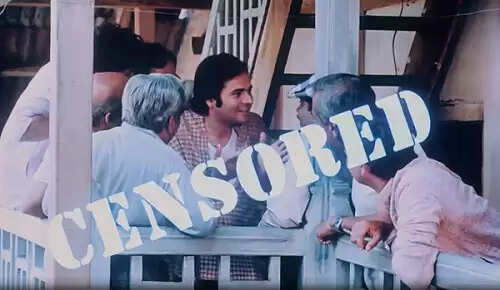50 Years of Emergency: A Reflection on Censorship in Indian Cinema

The Dark Legacy of the Emergency
Exactly 50 years ago, on June 25, Prime Minister Indira Gandhi imposed a national Emergency in India. This period, lasting from 1975 to 1977, saw the suspension of fundamental rights and the arrest of opposition figures and pro-democracy activists.
The Union government has designated June 25 as 'Samvidhan Hatya Diwas' (Murder of the Constitution), a term that seems ironic given the ongoing restrictions on free speech during its tenure.
Filmmakers were among the many victims of this Emergency. A notable case of censorship was the treatment of Amrit Nahata’s film, Kissa Kursi Ka (The Tale of the Seat of Power).
Completed in April 1975, Nahata's satirical take on corruption under Indira Gandhi faced severe censorship, resulting in 51 cuts and a complete ban, with the then Information and Broadcasting Minister VC Shukla ordering the destruction of all existing prints.
After the Congress party's defeat in 1978, Nahata attempted to remake Kissa Kursi Ka, but even this version faced scrutiny. His son, Rakesh Nahata, recounted in 2015 that the new film was subjected to 25 cuts, highlighting how those in power often alter their stance, suppressing the truth.
Would a modern adaptation of Kissa Kursi Ka about the current government face similar challenges? With films now primarily stored digitally, the physical destruction of prints is less feasible, yet there are still numerous ways to suppress narratives about corruption and the oppression of citizens.
The 50th anniversary of the Emergency has sparked discussions about Indira Gandhi's legacy, the role of India's elites during her authoritarian rule, and the impact of her policies on Parliament, the judiciary, and the media. These discussions are particularly pertinent in today's climate of censorship affecting films, documentaries, and streaming content.
The Central Board of Film Certification, often referred to as the censor board, is actively working to identify content that could be seen as offensive or critical of the ruling Bharatiya Janata Party (BJP). In contrast, films that align with government narratives are celebrated.
For instance, the recent film Sitaare Zameen Par, featuring Aamir Khan, was required to remove the term 'kamal' (lotus), the BJP's electoral symbol, from a scene. Additionally, it was mandated to include a statement from Prime Minister Modi about India's commitment to inclusivity for people with disabilities by 2047, coinciding with the centenary of Indian Independence.
The censor board has also taken action against filmmakers who fail to show proper respect for elements of Indian culture that have been appropriated by the Hindutva movement, the political arm of the BJP.
Two Malayalam films featuring characters named Janaki faced delays, one starring BJP member Suresh Gopi, due to Janaki being another name for Sita from the Ramayana.
Attended a special screening of the film, "The Sabarmati Report," in the GMC Balayogi Auditorium, Parliament, on December 2, 2024, with the Honorable Prime Minister and other senior leaders. pic.twitter.com/bkg2aNeQdR
— Suressh Gopi (@TheSureshGopi) December 3, 2024
The film Janaki Vs State of Kerala, where Gopi portrays a lawyer for a sexual assault survivor, faced objections due to its title. In another upcoming Malayalam film, Token Number, a character named Janaki Abraham has been renamed Jayanthi.
Both films were initially approved by the censor board's Thiruvanthapuram office but were later sent to the Mumbai headquarters, where the revising committee suggested changes.
Previously, a three-tier certification process was in place, allowing filmmakers to appeal against unfavorable decisions. However, in 2021, the government abolished the appellate tribunal, leaving filmmakers vulnerable to the censor board's decisions.
This has been evident in the case of Punjab ’95, a film addressing enforced disappearances and extrajudicial killings during the Punjab insurgency. The film's producers have faced over 120 requested cuts, including the removal of references to human rights abuses.
The producers have appealed to the Bombay High Court, but no resolution has been reached. If the cuts are enforced, Punjab ’95 will be fundamentally altered.
The censor board has historically controlled Indian cinema, as films cannot be screened without a censor certificate. This oversight extends to film festivals, which must also seek approval from the ministry.
Streaming platforms adhere to a self-regulated code of conduct, but the BJP is not alone in opposing dissenting views. Throughout history, various governments have sought to dictate what content is permissible for Indian audiences.
Since Narendra Modi's rise to power in 2014, censorship has intensified, whether through government action or other influences. Films and shows that challenge the state, biopics of adversaries, critiques of policies, and even character names are scrutinized for conformity to the government's ideology.
Censorship extends beyond the censor board, as seen in controversies surrounding the Prime Video series Tandav and the shelving of the Netflix film Tees.
While pursuing political narratives has always been challenging, the current landscape lacks a neutral entity to mediate between the censor board's authority and filmmakers' creative rights.
Without bodies like the Film Certification Appellate Tribunal and absent government intervention against arbitrary censorship, filmmakers have learned to self-censor.
During the Emergency, while there were instances of censorship, Indira Gandhi sometimes intervened in favor of filmmakers, as seen with MS Sathyu’s Garm Hava, which was cleared after her intervention.
Today, if similar negotiations are occurring behind the scenes, they remain undisclosed to the public.
In the past, absurd censorship measures often elicited laughter, but the current climate presents far more serious threats to free expression.
Censorship is a grave issue, yet some filmmakers have sought to find humor in the absurdity of control. In Sai Paranjpye’s Katha, a character begins a joke that is abruptly muted, with the word 'censored' displayed on screen—a clever jab that likely wouldn't pass muster today.

.png)